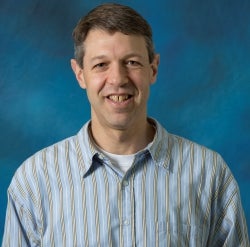Letter from the Chair
 One of the great pleasures of being an educator is the opportunity to marvel at how our students progress during their time at Pitt. Sometimes we even hear back from students after graduation, and it can be amazing to see where those wide-eyed freshmen who we remember from calculus class end up and what they manage to accomplish.
One of the great pleasures of being an educator is the opportunity to marvel at how our students progress during their time at Pitt. Sometimes we even hear back from students after graduation, and it can be amazing to see where those wide-eyed freshmen who we remember from calculus class end up and what they manage to accomplish.
The highlights of this semester's issue of "BY THE NUMB3RS" include articles that share some of the impressive accomplishments of our students. In the Undergraduate News section, you can read about conference presentations that our undergraduates recently delivered to national and even international audiences. We also have updates on summer internships that took our undergraduates to the foreign territories of Germany and of the PA State Senate! Our Alumni Spotlight shines on a recent graduate working in the red-hot field of data science.
In keeping with the emphasis on the youthful and/or new, this semester's newsletter welcomes the latest faculty addition to our department, Professor Carl Wang-Erickson, who works in arithmetic number theory. We also welcome, and share inspiring words from, our new Graduate Director, Professor Piotr Hajlasz, who took over the job from Professor David Swigon this fall.
For those faculty who may be far removed from our student days, we seek to nurture young talent and also to make our own contributions to the new, in the form of the cutting-edge research results and mathematical ideas that we develop. Our research section this semester features Professor Ming Chen, who has National Science Foundation funding to mathematically analyze how large-amplitude water waves form, persist and propagate. Our Michalik Lecture, delivered by the esteemed Professor Enrique Zuazua, the Alexander von Humboldt Professor of Applied Mathematics at Friedrich Alexander University in Erlangen-Nürnberg, also featured waves, but not those in the water. Rather, Professor Zuazua shared his recent research on how to control waves that arise in the spread of genes within populations, fires, and even phase transitions within materials, and you can read the details below.
Hopefully all of these exciting developments have you ready to do some mathematics of your own! Another accomplishment of two of our students was the successful completion of our September and October Undergraduate Contest Problems. You can try your hand at these problems, described in this newsletter, and we challenge you to solve our Newsletter Contest Problem and earn your own spot in the next issue of "BY THE NUMB3RS"!!
Best wishes,
-- Professor Jonathan Rubin, Chair, University of Pittsburgh, Department of Mathematics